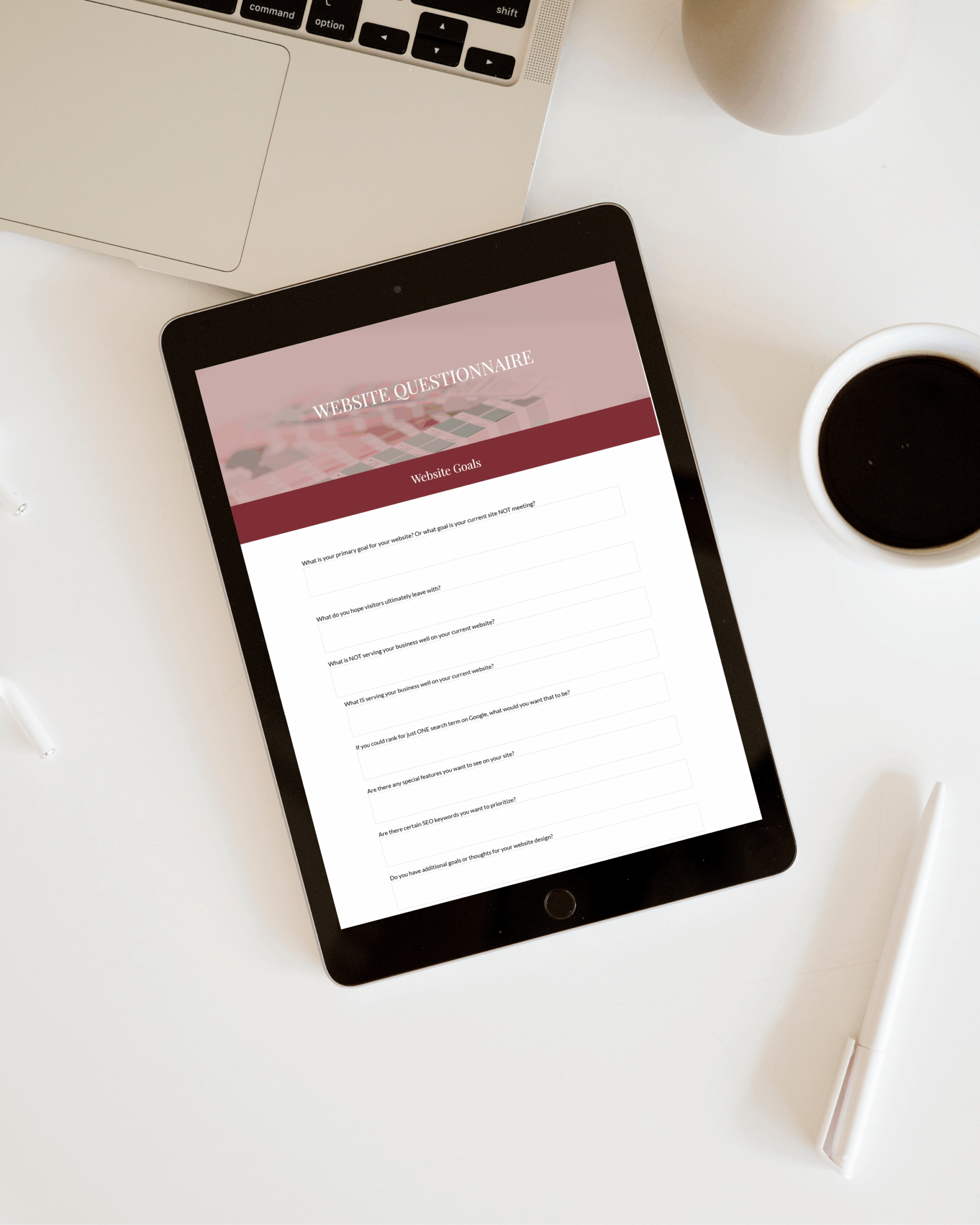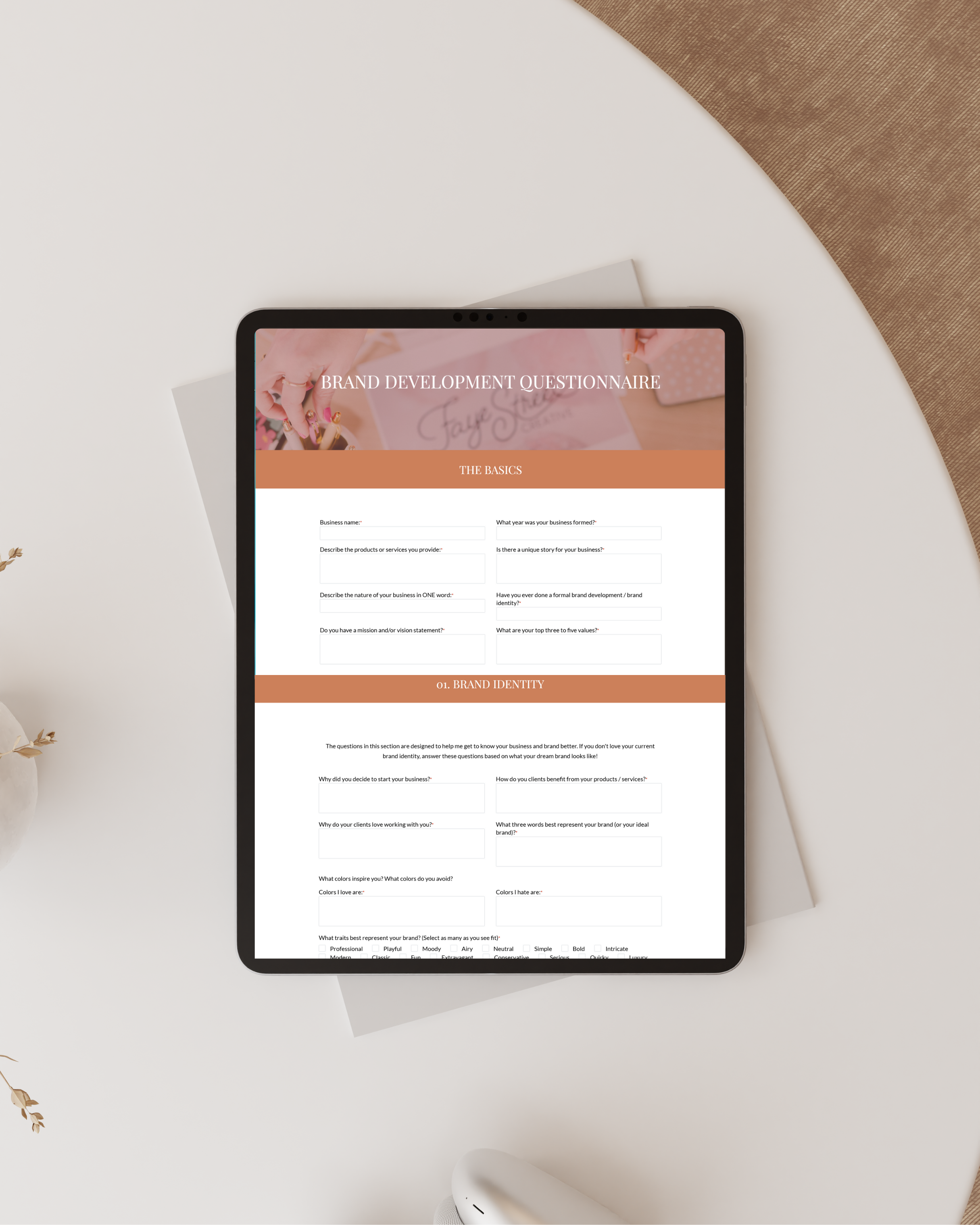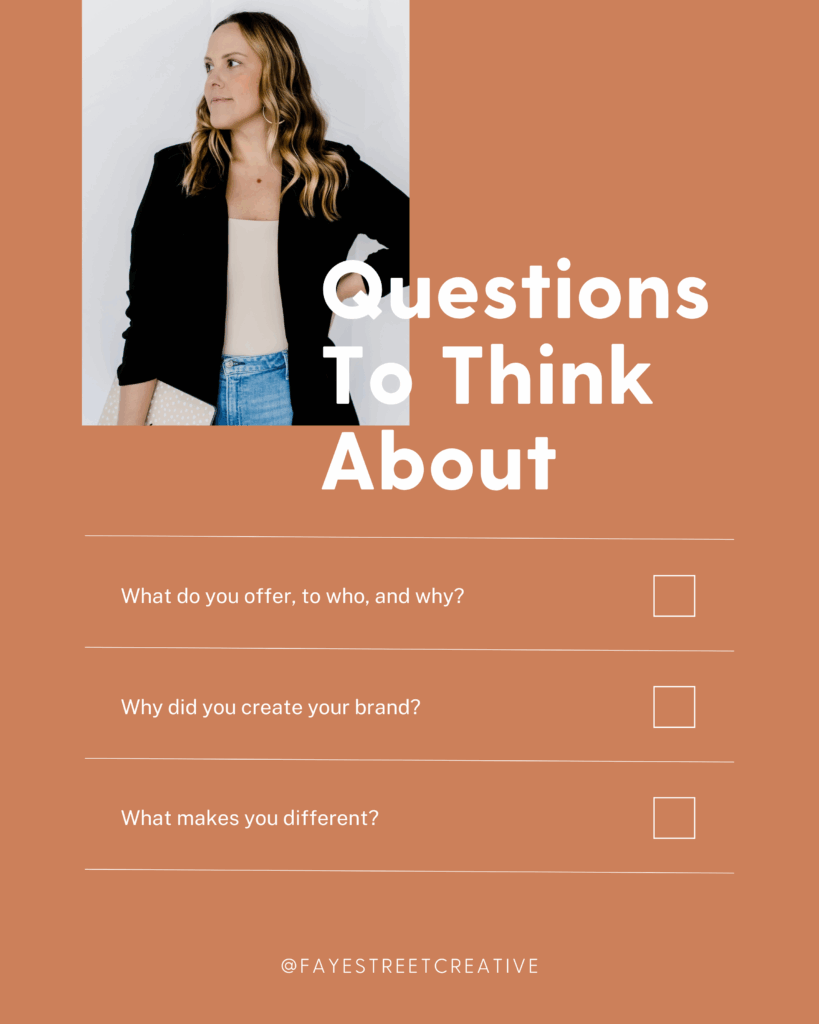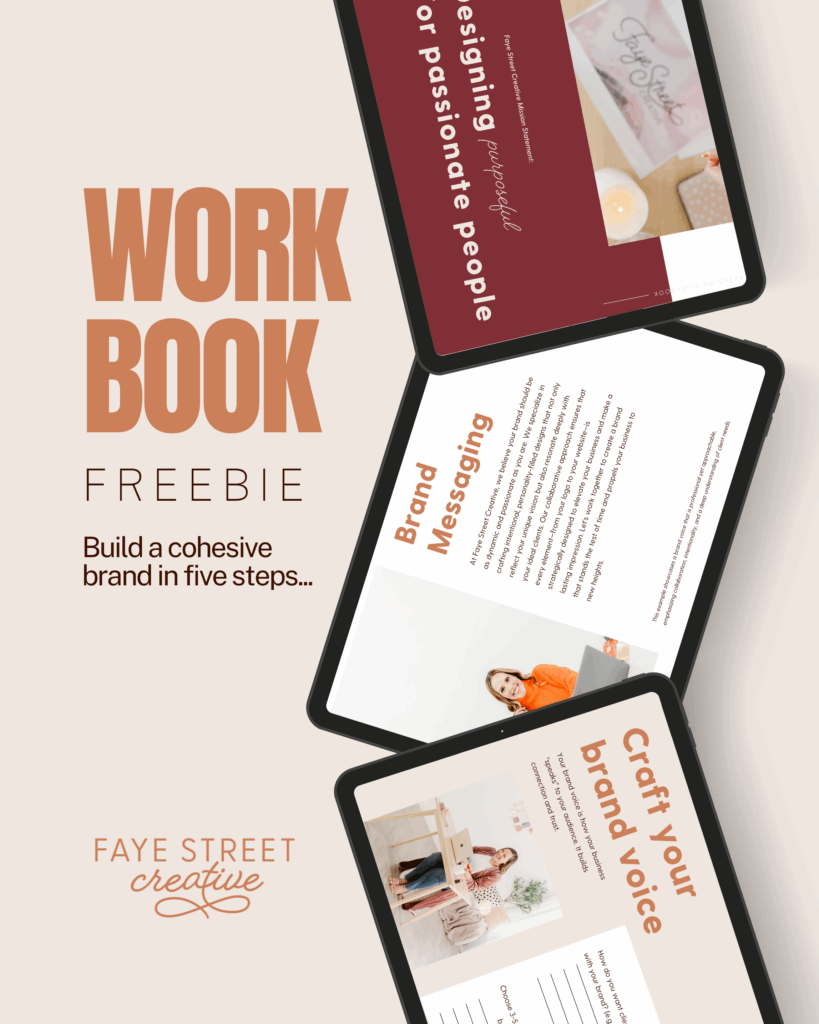menu
5 Brand Strategy Questions You Need to Know Before Working With a Designer
September 12, 2025
Have you ever visited a website and thought, “When was this last updated…2012?” Chances are, you didn’t end up staying on that site for too long.
That’s because it only takes 0.05 seconds for your brain to process a website and form a first impression.
And that first impression? It matters more than you think.
Website design influences 94% of all first impressions—so how your website looks is a big deal.
You might have started your business with a logo from Canva and a font you liked, but once you’re ready to take your small business to the next level, you need to invest in professional design.
Like any project, being prepared is crucial for success.
5 Essential Brand Strategy Questions
Many business owners dive into design projects without answering critical branding questions, leading to delays, extra revisions, and designs that don’t quite fit.
Before hiring that designer, ensure you have these brand strategy questions figured out. Trust me, your designer will thank you!
Brand Strategy Question 1: What is your brand’s basic info?
It might seem like a given, but you need to be crystal clear about this information before starting any design projects.

Brand Name and Domain
Your brand name must be 100% finalized before starting any design work. That means registering your business, ensuring the domain you want is available, and checking for businesses with a similar name that might confuse your customers.
If you haven’t purchased your domain yet, do it now. Good designers will ask about this early, as it affects many decisions down the line.
Location and Availability
Will your business serve local customers, operate nationally, or go global? Are you planning to have a brick-and-mortar location or operate fully online?
This affects design elements like:
- Contact information
- Location maps
- Time zone considerations
- Language options
Be clear about your business hours, response times, and geographic service area.

Brand Strategy Question 2: Why did you create your brand?
Your Brand’s Purpose and Mission
Designers create visuals that tell your brand’s story. To do this well, they need to understand why your business exists in the first place—which means you need to be clear on that, too.
Be Ready to Answer:
- Why did you start this business?
- What problem does your business solve?
- What makes your approach different from your competitors?
- What change are you trying to create in the world or your industry?
These questions aren’t easy to answer, and you’ll need to take some time to think about your answers and ensure you feel good about them. Your answers will guide essential design choices that reflect your brand’s purpose and create the foundation for your brand visually.
Your Core Values
Values aren’t just nice words on your website – they should influence how your brand looks and feels. Think about 3-5 core values that truly represent what your business stands for. Your brand itself, not the work you create (yes, these can be different!).
Here are some examples:
- Integrity – Honesty and ethical behavior in all business dealings
- Quality – Commitment to excellence in products or services
- Innovation – Encouraging creative solutions and continuous improvement
- Accountability – Taking responsibility for actions and outcomes
- Community – Supporting and giving back to the local community
- Sustainability – Environmentally responsible business practices
- Diversity and inclusion – Valuing different perspectives and backgrounds
- Transparency – Open and honest communication
- Adaptability – Willingness to change and grow
- Passion – Genuine enthusiasm for the work
- Respect – Treating everyone with dignity and consideration
When designers understand your values, they can create visuals that match. A brand that values “sustainability” will look very different from one focused on “creating luxury experiences.”
Brand Strategy Question 3: What do you offer, to who, and why?
Services or Products
Have a clear list of what you offer, including your primary services or products, pricing, and delivery methods.
Designers need this information to create appropriate layouts so customers can easily navigate your website.
Your Ideal Customer
One of the biggest mistakes business owners make is trying to appeal to everyone. Great design speaks directly to your specific target audience. (So you need to have one!)
Before working with a designer, determine:
- Who your ideal customer is (age, gender, location, income level)
- What they value and care about
- What problems they’re trying to solve
- How they prefer to communicate
Don’t guess—get actual answers from your target audience. You can create a survey for current customers, add a question or two to your contact form, or conduct interviews.
The point is to gather insights about how people perceive your business. The more specific you can be, the better. Your designer will use this information to create work that resonates with the right people.
Brand Strategy Question 4: What makes you different?
Market
Understanding your place in the market is crucial before working with a designer. Take time to analyze:
- Your specific market segment (luxury, mid-range, budget)
- Whether your market is saturated or has gaps you can fill
- Current trends versus timeless approaches in your industry
- Geographic considerations (local, regional, national, global)

This analysis helps designers position your brand appropriately and avoid creating visuals that send mixed messages about your work.
Competitors
Who are your competitors? Choose businesses that are in the same industry AND market segment as you.
Sure, one day, you might wanna compete against the best in the business, but if that’s not where you’re at right now, those people aren’t your direct competitors. Consider things like audience, pricing, deliverables, and location (if that applies).
For each competitor, note:
- Their core messaging and values
- Visual identity strengths and weaknesses
- Areas where they’re excelling
- Gaps or weaknesses you could address
This isn’t about copying what works but understanding the landscape so you can stand out meaningfully.
Unique Selling Proposition (USP)
Your USP is what makes you different. Clearly articulate what makes your business special:
- Unique approach or methodology
- Specialized expertise or background
- Distinctive client experience
- Proprietary processes or technology
- Values that guide your work
- Quality, service, or experience differentiators
- Client results or testimonials that highlight your unique approach
- Specialized offerings competitors don’t provide
- Guarantees or promises that only you can make
Being specific helps designers translate your uniqueness into visual elements that communicate your unique approach.
Brand Strategy Question 5: How do you want your brand represented visually?
Brands You Admire
One of the best ways to communicate with designers is to show examples of brands you like. Ask yourself these personal brand questions and collect 3-5 examples of businesses (not necessarily competitors) whose visual style resonates with you.
For each example, note specifically what you like:
- Overall feel and vibe
- Color schemes
- Typography (font choices)
- Image style
- Layout preferences
- Site navigation
- User experience
This gives designers a starting point while allowing them creative freedom to develop a design that reflects your distinctive brand.

Existing Visual Elements
If you already have some brand elements, gather them all in one place:
- Logo (all versions and formats)
- Brand colors (with exact color codes if available)
- Fonts you currently use
- Business cards, brochures, or other materials
- Existing website or social media accounts
- Professional headshots
- Team photos
- Product images
- Office or location shots
- Before/after examples of your work
Even if you’re abandoning your current branding, having these materials will help your designer determine the direction for your new brand.
Choosing the perfect designer to create your brand identity
Coming prepared to your designer with answers to these branding questions won’t just make the process smoother—it will result in a final product that truly works for your business.
Don’t worry if you don’t have all these elements perfectly defined. A good designer will help you clarify your vision. The important thing is to start thinking about these aspects of your business before your first meeting.
Choosing the designer with that responsibility is an important decision. At Faye Street Creative, it’s my mission to create brand visuals that do way more than look pretty.
The best design isn’t just beautiful; it’s strategic and aligned with your business goals. It works for you so you can focus on more important things, like doing what you do best: serving your customers.
I’d love to help you decide if we’d be a good fit. Check out my work, download a free branding workbook, or reach out to get the conversation started! We’ll get your new branding up and running in no time!
Leave a Reply Cancel reply
Want to fill your IG feed with
pretty branding things?
You’ll find lots of logos and website designs from fantastic brands I’ve worked with, and of course all the color palettes, oh, and lots of biz resources to help you elevate your existing brand and stand out in the crowd.
Let's Connect
Emily is the founder of Faye Street Creative, a boutique branding agency providing branding and web design services. Faye Street specializes in Showit website design and brand development for small businesses.
Based in Richmond, Virginia
and working with badass business owners worldwide.
stay in touch
Privacy Policy
© Faye Street Creative // powered by showit